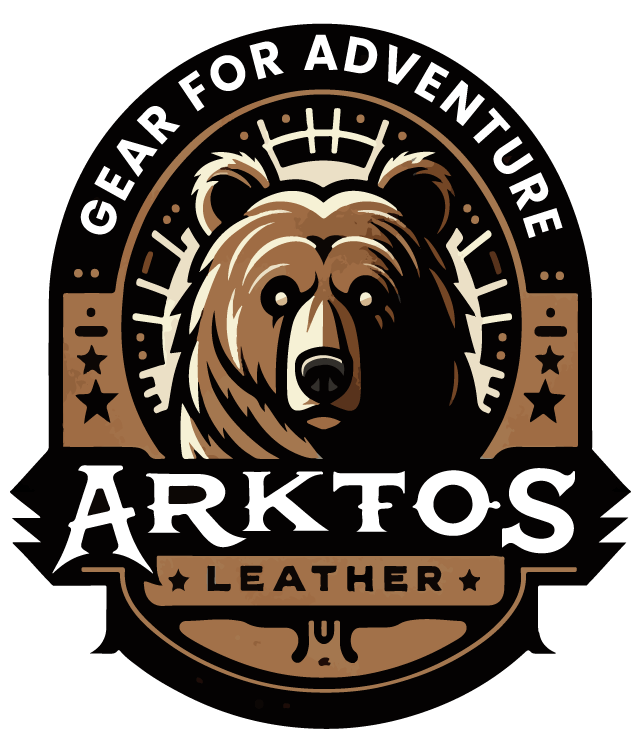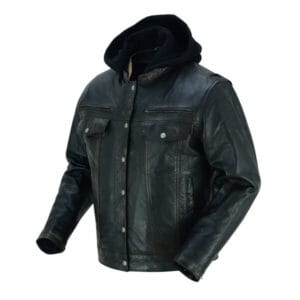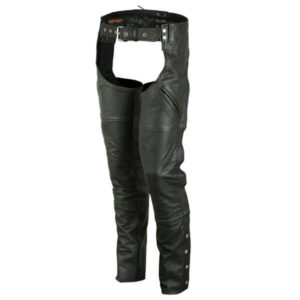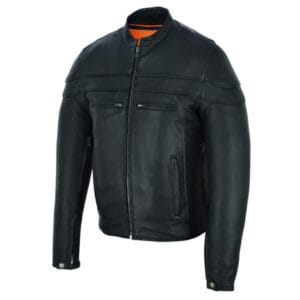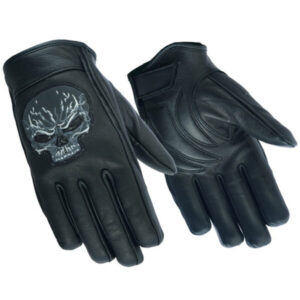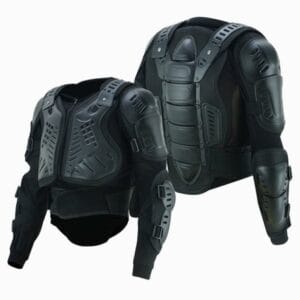The use of leather in motorcycle gear has a long and storied history. Initially, leather was adopted by early motorcyclists due to its availability and inherent protective qualities. Over the years, leather gear has evolved from simple jackets and pants to highly specialized garments designed to offer maximum protection and comfort. Early riders often wore repurposed military jackets, which later inspired the development of dedicated motorcycle gear.
Why Leather Became Popular As Motorcycle Gear
Leather became popular among motorcyclists for several reasons:
- Natural resistance to abrasion: Leather is inherently tough and can withstand the scrapes and impacts common in motorcycle accidents.
- Protection against the elements: Leather provides excellent protection against wind, rain, and cold, making it ideal for riders exposed to the elements.
- Aesthetic appeal: The classic look of leather has a timeless appeal, contributing to its popularity among riders.
Men’s Lightweight Drum Dyed Distressed Naked Lambskin Leather M/C Jacket
Properties of Leather
Durability and Strength
One of the most significant advantages of leather is its durability and strength. High-quality leather can withstand considerable wear and tear, making it an ideal material for motorcycle gear. Its dense fibers provide excellent resistance to abrasions, protecting the rider’s skin in case of a fall.
Flexibility and Comfort
Leather offers a unique combination of flexibility and comfort. Unlike synthetic materials, leather conforms to the wearer’s body over time, providing a custom fit. This adaptability ensures that leather gear is comfortable for long rides, reducing fatigue and enhancing the rider’s overall experience.
Breathability and Temperature Regulation
Another critical property of leather is its breathability and temperature regulation. Leather allows air to circulate, which helps to keep the rider cool in hot weather and warm in cold conditions. This natural breathability prevents excessive sweating, making leather gear suitable for various climates and riding conditions.
What is Road Rash?
Road rash is a type of skin abrasion that occurs when the skin comes into contact with rough surfaces, typically as a result of falling or sliding on the pavement during a motorcycle, bicycle, or similar accident. This injury can range from mild to severe, involving superficial scrapes to deep wounds that can cause significant pain and potential complications if not treated properly.
Common Causes of Road Rash
Road rash is commonly caused by high-speed activities where the individual is exposed to the risk of falling or sliding across a rough surface. Some of the most frequent causes include:
- Motorcycle accidents: Riders falling off their bikes and sliding across the pavement.
- Bicycle accidents: Cyclists losing balance and skidding on the road.
- Skateboarding or rollerblading falls: Enthusiasts hitting the ground at high speeds.
- Sports activities: Such as running, soccer, or other outdoor activities, where slipping and falling are common.
Severity Levels of Road Rash
The severity of road rash can be classified into three levels:
Mild (First-Degree)
This type involves superficial damage to the top layer of the skin. Symptoms include:
- Redness
- Mild swelling
- Minor pain
First-degree road rash typically heals within a week with minimal treatment, such as cleaning the wound and applying antiseptic.
Moderate (Second-Degree)
Moderate road rash penetrates deeper into the skin layers and might include:
- Bleeding
- Swelling
- Increased pain
Treatment involves thorough cleaning, possible removal of debris, and regular dressing changes to prevent infection. Healing can take several weeks.
Severe (Third-Degree)
Severe road rash affects all layers of the skin and can reach underlying tissues. Characteristics include:
- Significant bleeding
- Intense pain
- Potential for infection and scarring
Medical intervention is often necessary, including antibiotics, pain management, and possibly skin grafts. Healing can take months and may result in permanent scars.
Black Leather Dual Deep Pocket Thermal Lined Motorcycle Chaps
Purpose of Protective Gear
Importance of Protective Gear for Riders
The primary purpose of protective gear is to mitigate the risk of injuries like road rash by providing a barrier between the skin and the rough surface. Effective protective gear can drastically reduce the severity of injuries sustained during accidents. Here are some key reasons why protective gear is essential:
- Prevents abrasions and cuts: Quality gear absorbs the friction and impact, reducing skin damage.
- Reduces infection risk: By keeping the skin intact, the risk of debris entering wounds is minimized.
- Enhances visibility: Bright and reflective gear increases the rider’s visibility to other motorists, reducing the likelihood of accidents.
Overview of Different Types of Protective Gear
Protective gear comes in various forms, each designed to protect different parts of the body. Here’s an overview:
D.O.T German Motorcycle Helmet – Dull Black
Helmets
Helmets are crucial for protecting the head and brain from traumatic injuries. A good helmet should fit snugly, meet safety standards, and provide ample cushioning.
 Men’s Natural Soft Leather Vented Motorcycle Jacket W/ Thermal Liner
Men’s Natural Soft Leather Vented Motorcycle Jacket W/ Thermal Liner
Jackets
Motorcycle and bicycle jackets are typically made from abrasion-resistant materials like leather or reinforced textiles. These jackets often include padding in critical areas such as the elbows, shoulders, and back.
Reflective Skull Short Leather Gloves
Gloves
Gloves protect the hands, which are often instinctively used to break a fall, leading to severe abrasions. Quality gloves offer padding, abrasion resistance, and flexibility.
Women’s Lightweight Leather Two Tone Motorcycle Hip Set Chaps
Pants
Protective pants and biker chaps are made from durable materials and often feature additional padding in areas prone to impact. They protect the legs from road rash and other injuries.
Men’s Waterproof Black Harness Boots
Boots
Boots designed for riding offer ankle support, protection against impacts, and are made from tough materials to withstand abrasion.
Black Full Body Protection Motorcycle Armor
Armor
Body armor can be worn under or over clothing to provide extra protection. Common types include:
- Chest protectors: Shield the torso from impacts.
- Knee and elbow guards: Protect joints from abrasions and fractures.
- Spine protectors: Offer additional support and protection for the back.
Effectiveness of Leather in Preventing Road Rash
Scientific Studies and Data
Research on Leather’s Protective Qualities
Leather has long been valued for its protective qualities in motorcycle gear, and various scientific studies have confirmed its effectiveness. Research indicates that leather is highly resistant to abrasions and can significantly reduce the risk of road rash during accidents. Its dense fiber structure provides a robust barrier against the rough surfaces that riders might encounter in a crash.
A study published in the Journal of Trauma found that leather motorcycle jackets significantly decrease the severity of skin abrasions and injuries compared to non-protective clothing. This research highlights leather’s ability to absorb and disperse impact forces, thereby minimizing skin damage.
Case Studies of Accidents
Numerous case studies have documented the protective benefits of leather gear in real-world accidents. For example, an analysis of motorcycle crash data from the Hurt Report—a comprehensive motorcycle accident study—revealed that riders wearing leather clothing had a lower incidence of severe skin abrasions compared to those wearing regular clothing. These findings underscore leather’s effectiveness in protecting against road rash and other injuries.
Real-World Testimonials
Rider Experiences with Leather Gear
Riders often share testimonials about their experiences with leather gear, many of which highlight its protective qualities. For instance, motorcyclists involved in high-speed accidents have reported that their leather jackets and pants prevented significant skin injuries. These personal accounts provide compelling evidence of leather’s real-world effectiveness.
Comparing Different Experiences
When comparing experiences, riders frequently note that leather gear offers superior protection compared to textile or non-protective clothing. Many report that while textiles can offer good protection, leather’s ability to conform to the body and its durability provide an extra layer of security. However, some riders prefer textiles for their lighter weight and better ventilation in hot weather.
Limitations of Leather
Scenarios Where Leather May Fall Short
While leather is highly effective in preventing road rash, there are scenarios where it may fall short:
- Extreme weather conditions: In very hot or wet climates, leather can become uncomfortable. It can get excessively hot in the sun and heavy when wet, potentially reducing mobility and comfort.
- Limited visibility: Leather gear, often available in darker colors, may not offer the high visibility that some textile gear provides, which is crucial for rider safety in low-light conditions.
Potential Drawbacks
Potential drawbacks of leather gear include:
- Maintenance requirements: Leather requires regular cleaning and conditioning to maintain its protective qualities and longevity. Neglecting maintenance can lead to the material becoming stiff, cracked, and less effective.
- Cost: High-quality leather gear can be expensive, which might be a barrier for some riders. The initial investment is higher compared to many textile alternatives.
- Weight: Leather gear is typically heavier than textile gear, which can be a drawback for long-distance riders or those who prioritize lightweight gear.
Despite these limitations, leather remains a popular and effective choice for motorcycle gear due to its proven ability to prevent road rash and its enduring durability.
Leather vs. Other Materials
Comparing Leather with Synthetic Materials
Strength and Durability
When comparing strength and durability, leather has traditionally been seen as superior due to its natural toughness. Leather’s dense fiber structure offers excellent abrasion resistance, making it a preferred choice for motorcycle gear. Synthetic materials, such as Cordura or Kevlar, have been engineered to provide similar levels of protection and, in some cases, exceed leather’s capabilities in terms of tear resistance and impact absorption.
Comfort and Fit
Leather is renowned for its comfort and fit. Over time, leather conforms to the rider’s body, creating a custom fit that enhances comfort during long rides. Synthetics, while often lighter and more flexible from the start, may not provide the same personalized fit that leather does. However, modern synthetic materials are designed with ergonomics in mind and often include stretch panels and adjustable features to improve comfort.
Cost and Accessibility
Cost and accessibility are significant factors in choosing between leather and synthetic materials. Leather gear tends to be more expensive due to the cost of materials and the craftsmanship involved in its production. Synthetic materials are generally more affordable and widely available, making them a practical choice for budget-conscious riders. Additionally, synthetics can be produced in a wider range of styles and colors, offering more options for personalization.
Leather vs. Textile
Abrasion Resistance
Abrasion resistance is a critical factor in evaluating motorcycle gear. Leather is highly resistant to abrasions and provides excellent protection against road rash. Textile materials, especially those reinforced with Kevlar or other durable fibers, can also offer high levels of abrasion resistance. However, the performance of textiles can vary widely depending on the quality and thickness of the fabric used.
Weather Resistance
When it comes to weather resistance, textile materials often have the upper hand. Many synthetic motorcycle gears are designed to be waterproof and windproof, incorporating features like breathable membranes and sealed seams to keep riders dry and comfortable in various weather conditions. Leather, while naturally resistant to wind and somewhat to rain, requires regular treatment to maintain its weather-resistant properties and can become heavy and less breathable when wet.
Maintenance and Longevity
Maintenance and longevity are important considerations for any motorcycle gear. Leather requires regular care, including cleaning and conditioning, to prevent it from drying out and cracking. With proper maintenance, leather gear can last for many years, developing a unique patina over time. Synthetic materials typically require less maintenance and are often easier to clean. However, the longevity of textiles can be shorter than leather, as synthetic fibers may degrade or lose their protective qualities after prolonged exposure to UV light and repeated washings.
Enhancing Leather Gear for Better Protection
Leather Treatments and Coatings
Waterproofing and Weatherproofing
To enhance the protective qualities of leather gear, waterproofing and weatherproofing treatments are essential. These treatments involve applying specialized coatings that repel water and prevent moisture from penetrating the leather. Common methods include:
- Wax treatments: Applying beeswax or other waterproofing waxes creates a barrier that helps keep the leather dry.
- Silicone sprays: These sprays add a waterproof layer without compromising the leather’s breathability.
- Oil treatments: Mink oil or neatsfoot oil can be used to condition and waterproof leather, maintaining its flexibility and preventing it from becoming brittle.
Enhancing Abrasion Resistance
Enhancing abrasion resistance can be achieved through several techniques. Treatments and coatings designed to increase the toughness of leather include:
- Ceramic coatings: These provide an additional layer of protection against abrasions and can significantly increase the lifespan of the gear.
- Kevlar linings: Integrating Kevlar fibers into the lining of leather gear enhances its resistance to tearing and abrasions without compromising comfort.
Reinforcements and Padding
Adding Armor and Padding
For optimal protection, leather gear can be reinforced with armor and padding. Key areas for reinforcement include:
- Shoulders, elbows, and knees: Adding CE-rated armor to these high-impact areas can significantly reduce the risk of injury during a fall.
- Back protectors: Incorporating spinal protection can prevent severe back injuries. Modern back protectors are lightweight and flexible, ensuring comfort without sacrificing safety.
- Hip and chest protectors: Additional padding in these areas can further enhance the protective qualities of leather gear.
Stitching and Construction Techniques
The stitching and construction techniques used in leather gear play a crucial role in its overall durability and effectiveness. Important considerations include:
- Double or triple stitching: Using multiple rows of stitching in high-stress areas prevents seams from bursting during an impact.
- Reinforced seams: Strengthening seams with heavy-duty thread and specialized stitching patterns can enhance the overall strength of the gear.
- Bonded nylon or polyester thread: These types of thread are more durable and resistant to abrasion, ensuring the longevity of the gear.
Practical Tips for Riders
Choosing the Right Leather Gear
How to Select Quality Leather
When choosing leather gear, it is crucial to select high-quality leather that will offer the best protection and durability. Here are some tips to help you make an informed decision:
- Check the leather type: Full-grain leather is the highest quality, offering the best protection and longevity. Top-grain leather is also a good option, while split leather is less durable.
- Examine the thickness: Thicker leather (around 1.2-1.4 mm) provides better abrasion resistance. Look for gear that specifies the thickness of the leather used.
- Look for certifications: Ensure the gear meets safety standards such as CE certification for added peace of mind.
- Inspect the craftsmanship: High-quality leather gear will have tight, even stitching and reinforced seams. Avoid gear with loose threads or uneven stitching, as these can indicate poor construction.
Fit and Comfort Considerations
For optimal protection and comfort, it’s important to choose leather gear that fits well. Consider the following:
- Try before you buy: If possible, try on the gear to ensure it fits snugly but comfortably. The gear should not restrict movement, but it should be tight enough to stay in place during an accident.
- Check for adjustability: Look for gear with adjustable straps, zippers, and Velcro to fine-tune the fit. This ensures a more personalized and secure fit.
- Consider riding position: Ensure the gear is comfortable in your typical riding position. Some gear may feel great when standing but uncomfortable when sitting on a motorcycle.
- Layering: Allow room for layering underneath the gear, especially if you ride in varying weather conditions. However, avoid too much extra space, as loose gear can shift and reduce protection during a crash.
Caring for Your Leather Gear
Cleaning and Maintenance Tips
Proper care and maintenance can extend the life of your leather vests and other gear and maintain its protective qualities. Follow these tips for cleaning and maintenance:
- Regular cleaning: Wipe down your leather gear with a damp cloth to remove dirt and debris after each ride. For deeper cleaning, use a leather-specific cleaner.
- Conditioning: Apply a leather conditioner every few months to keep the leather supple and prevent it from drying out and cracking. Avoid using too much conditioner, as this can weaken the leather.
- Waterproofing: Periodically treat your motorcycle gear with a waterproofing product to maintain its resistance to water and moisture. Be sure to reapply after heavy exposure to rain or after cleaning.
Repairing and Restoring Leather
Even high-quality leather gear can experience wear and tear. Here are some tips for repairing and restoring your gear:
- Minor repairs: Small scratches and scuffs can be treated with a leather repair kit, which typically includes a patch, adhesive, and color-matching dye.
- Stitching repairs: If a seam starts to come undone, have it repaired by a professional or use a heavy-duty needle and thread to fix it yourself.
- Restoring color: Leather dye can be used to restore faded areas. Apply the dye evenly and allow it to dry completely before conditioning the leather.
- Professional restoration: For extensive damage, consider taking your gear to a professional leather repair service. They can provide more comprehensive repairs and restorations, ensuring your motorcycle gear remains in top condition.
Alternative Protective Gear
Kevlar and Dyneema
Properties and Benefits
Kevlar and Dyneema are two popular synthetic materials used in protective motorcycle gear. Both materials offer unique properties and benefits:
- Kevlar:
- High tensile strength: Kevlar is known for its incredible strength-to-weight ratio, making it highly resistant to tears and abrasions.
- Heat resistance: Kevlar can withstand high temperatures, providing protection in the event of a slide across hot pavement.
- Lightweight: Despite its strength, Kevlar is lightweight, which contributes to overall comfort and ease of movement.
- Dyneema:
- Extremely high strength: Dyneema is one of the strongest fibers available, offering exceptional cut and abrasion resistance.
- Lightweight and flexible: Dyneema is lighter and more flexible than Kevlar, enhancing comfort without compromising protection.
- Moisture resistance: Dyneema does not absorb water, making it ideal for wet conditions.
Comparisons with Leather
When comparing Kevlar and Dyneema with leather, several factors should be considered:
- Abrasion resistance: Leather has long been favored for its abrasion resistance, but Kevlar and Dyneema offer comparable or even superior protection in some cases.
- Weight and flexibility: Kevlar and Dyneema are significantly lighter and more flexible than leather, making them more comfortable for long rides.
- Weather resistance: Kevlar and Dyneema perform better in wet conditions, as they do not absorb moisture like leather. This makes them more suitable for riding in various weather conditions.
- Maintenance: Synthetic materials require less maintenance than leather. They are easier to clean and do not need regular conditioning to maintain their properties.
Mesh and Textile Gear
Advantages in Different Weather Conditions
Mesh and textile gear offer several advantages, particularly in different weather conditions:
- Breathability: Mesh gear provides excellent ventilation, making it ideal for hot weather. It allows air to circulate, keeping the rider cool and reducing the risk of overheating.
- Waterproofing: Many textile jackets and pants are designed with waterproof or water-resistant properties, making them suitable for riding in the rain.
- Layering: Textile gear often features removable liners for added warmth in cold weather or extra ventilation in hot conditions. This versatility makes it a practical choice for riders who experience a range of climates.
Protective Qualities
The protective qualities of mesh and textile gear can vary depending on the materials and construction techniques used:
- Abrasion resistance: While not as inherently abrasion resistant as leather, high-quality textile gear often includes reinforcements with materials like Kevlar or Cordura to enhance protection.
- Impact protection: Many textile jackets and pants come equipped with CE-rated armor in critical areas like the shoulders, elbows, knees, and back. This armor helps absorb and distribute impact forces, reducing the risk of injury.
- Visibility: Textile gear is often available in bright colors and can include reflective elements to improve visibility, enhancing rider safety in low-light conditions.
In summary, Kevlar and Dyneema offer high strength, lightweight, and moisture-resistant alternatives to leather, while mesh and textile gear provide excellent breathability, weather versatility, and impact protection. Each type of motorcycle gear has its unique advantages, and riders should choose based on their specific needs, riding conditions, and personal preferences.
Conclusion
Leather is highly effective in preventing road rash due to its excellent abrasion resistance, durability, and protective qualities. Scientific studies, case reports, and rider testimonials consistently demonstrate that leather motorcycle gear significantly reduces the severity of skin injuries during accidents. While it has some limitations, such as the need for regular maintenance and potential discomfort in extreme weather, leather remains a popular and trusted choice for motorcycle protection.
